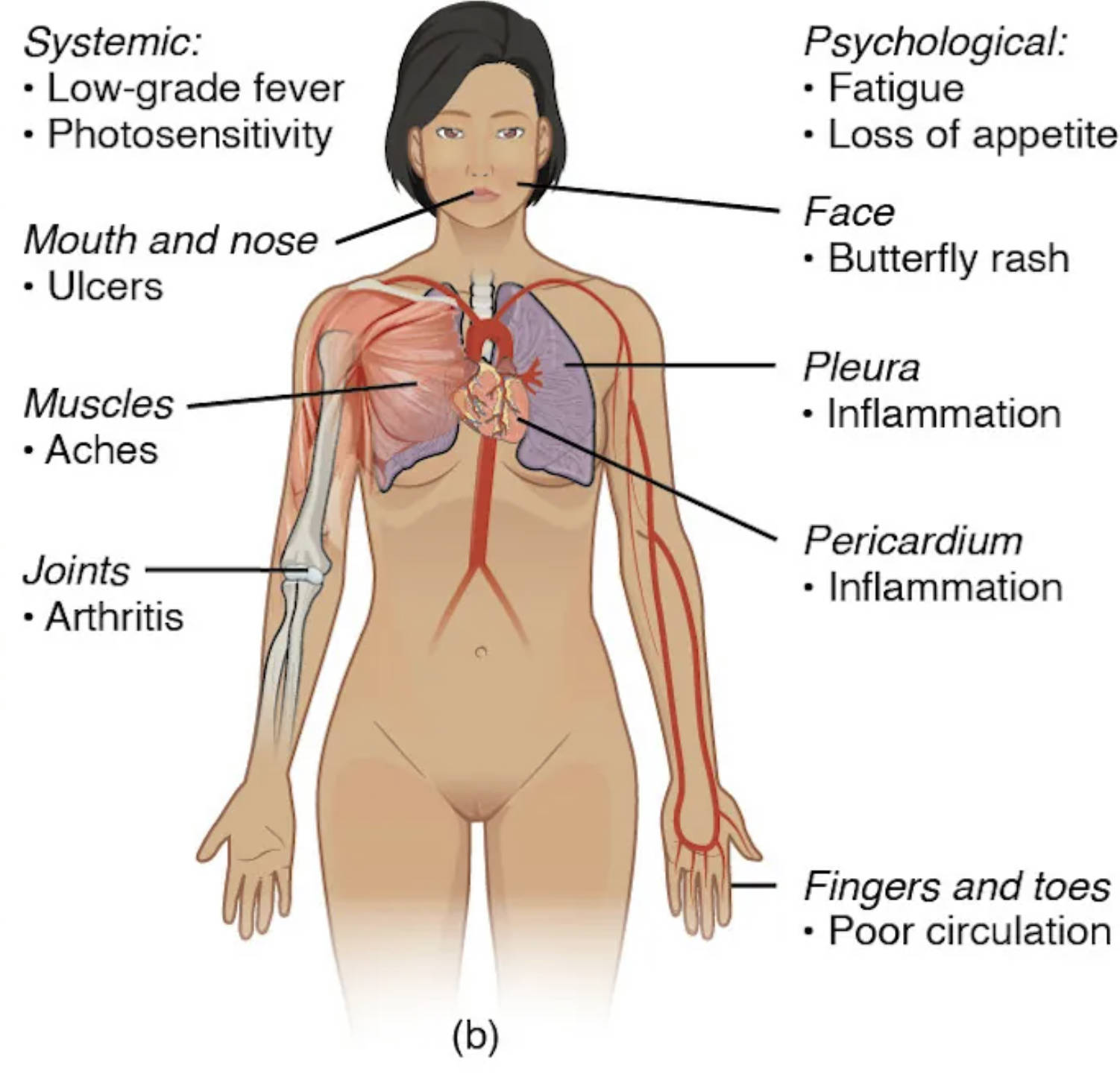Systemic lupus erythematosus (SLE), commonly known as lupus, is a chronic autoimmune disease that can affect multiple organs and systems, presenting a wide range of symptoms. This diagram highlights the diverse manifestations of SLE, from systemic effects like fever to specific organ involvement such as pleura and pericardium inflammation. Gaining a thorough understanding of these symptoms is essential for recognizing and managing this complex condition effectively.

Key Labels in the Lupus Symptoms Diagram
This section provides detailed explanations for each labeled area, shedding light on the varied impacts of lupus.
Systemic: This category includes general symptoms like low-grade fever and photosensitivity, affecting the entire body. These signs indicate the widespread nature of the autoimmune response in lupus.
Recommended Study Resource
Gray's Anatomy: The Anatomical Basis of Clinical Practice
Enhance your anatomical knowledge with Gray's Anatomy: The Anatomical Basis of Clinical Practice. This authoritative text offers in-depth insights and illustrations, perfect for medical students and practitioners aiming for clinical excellence.
At AnatomyNote.com, we offer free resources on anatomy, pathology, and pediatric medicine for medical students and professionals. Purchasing through our Amazon links, like Gray's Anatomy, supports our server costs and content creation at no additional cost to you.
Disclosure: As an Amazon Associate, we earn a commission from qualifying purchases.
Disclosure: As an Amazon Associate, we earn a commission from qualifying purchases at no extra cost to you.
Psychological: Encompassing fatigue and loss of appetite, these symptoms reflect the mental and emotional toll of lupus. They can significantly impact quality of life and require careful monitoring.
Mouth and nose: This area may develop ulcers, serving as a visible sign of lupus activity. These sores can cause discomfort and are often a diagnostic clue for the disease.
Muscles: Muscle aches are common, resulting from inflammation or autoimmune attack on muscle tissue. They contribute to the overall physical burden experienced by individuals with lupus.
Joints: Arthritis in the joints, marked by pain and swelling, is a frequent symptom of lupus. This inflammation can lead to joint deformity if untreated, affecting mobility.
Anatomy Flash Cards
Master anatomy with detailed, exam-ready flash cards.
AnatomyNote.com offers free anatomy and pathology resources. Your purchase of Anatomy Flash Cards supports our site at no extra cost.
As an Amazon Associate, we earn from qualifying purchases.
Pleura: Inflammation of the pleura, the membrane surrounding the lungs, can cause chest pain and breathing difficulties. This condition, known as pleuritis, is a serious lupus manifestation.
Pericardium: Inflammation of the pericardium, the sac around the heart, may lead to chest pain or pericarditis. It highlights the cardiovascular involvement in lupus progression.
Fingers and toes: Poor circulation in these extremities can result in Raynaud’s phenomenon, causing color changes and numbness. This symptom underscores lupus’s impact on vascular health.
Face: The characteristic butterfly rash across the cheeks and nose is a hallmark of lupus, often triggered by sun exposure. It serves as a key diagnostic feature of the disease.
Understanding Systemic Lupus Erythematosus
Lupus is an autoimmune condition where the immune system attacks healthy tissues. Its symptoms vary widely, making diagnosis challenging.
- Systemic effects like low-grade fever signal an ongoing inflammatory process.
- Psychological symptoms such as fatigue arise from chronic inflammation and energy depletion.
- The disease can flare up, with periods of remission and exacerbation.
- Genetic and environmental factors, including UV light, contribute to its onset.
- Early recognition of symptoms is crucial for effective management.
Musculoskeletal and Joint Involvement
Joint and muscle symptoms are among the most common in lupus. They significantly affect daily functioning.
- Joints exhibit arthritis, often affecting the hands, wrists, and knees.
- Muscles aches result from myositis or general inflammation.
- Joint inflammation can lead to synovitis, causing stiffness.
- Non-erosive arthritis distinguishes lupus from rheumatoid arthritis.
- Physical therapy can help maintain mobility during flares.
Organ-Specific Manifestations
Lupus can impact vital organs, leading to serious complications. Monitoring these areas is essential.
- Pleura inflammation causes pleuritic pain, often requiring anti-inflammatory treatment.
- Pericardium involvement may lead to pericardial effusion if severe.
- Lung and heart involvement increases morbidity risk.
- Echocardiograms and chest X-rays aid in assessing organ damage.
- Immunosuppressive therapy targets these inflammatory responses.
Dermatological and Vascular Symptoms
Skin and vascular changes are prominent lupus features. They offer visible clues to the disease.
- The face butterfly rash is photosensitive, worsening with sun exposure.
- Fingers and toes poor circulation manifests as Raynaud’s phenomenon.
- Rash severity correlates with disease activity.
- Sunscreen and protective clothing help manage photosensitivity.
- Vascular issues may precede other systemic symptoms.
Oral and Psychological Impacts
Mucosal and mental health effects add to lupus’s complexity. Addressing these improves patient outcomes.
- Mouth and nose ulcers indicate active disease and require topical treatments.
- Psychological fatigue and appetite loss stem from chronic stress and inflammation.
- Ulcers can affect eating and speech, necessitating care.
- Antidepressants or counseling support mental health.
- Nutritional support counters appetite loss during flares.
Diagnosis and Management Strategies
Recognizing lupus symptoms guides diagnosis and treatment. A multidisciplinary approach is key.
- Blood tests for antinuclear antibodies (ANA) confirm systemic involvement.
- Joints and muscles assessments help track disease progression.
- Corticosteroids reduce pleura and pericardium inflammation.
- Antimalarials like hydroxychloroquine treat skin and joint symptoms.
- Regular monitoring prevents long-term organ damage.
In conclusion, the lupus symptoms diagram illustrates the multifaceted nature of systemic lupus erythematosus, affecting everything from joints to psychological well-being. Understanding these diverse manifestations, from the face butterfly rash to fingers and toes circulation issues, is vital for timely intervention. With proper management, individuals can mitigate the impact of this chronic autoimmune condition and maintain a better quality of life.




